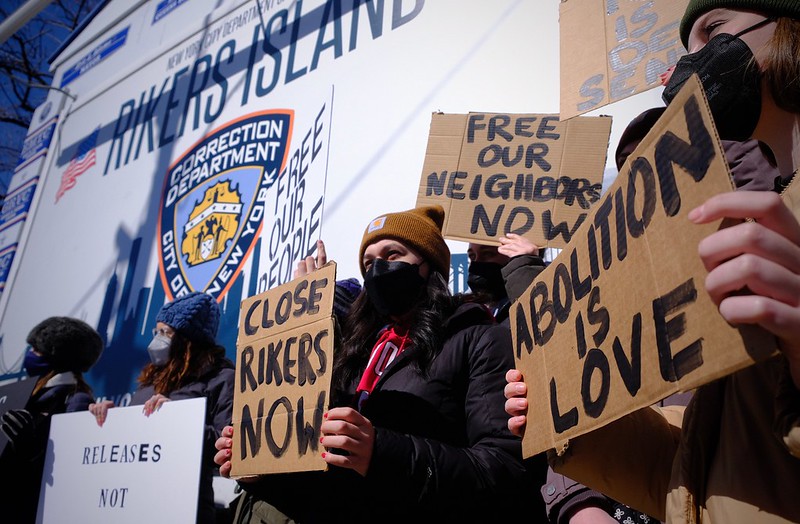
Outside Rikers Island jails (photo: Gerardo Romo/NYC Council Media Unit)
Rikers Island is a devastatingly terrible investment. New York City spends more on jails than anywhere else in the country – over $500,000 per person per year. Yet, violence rates dwarf those elsewhere.
The jails on Rikers Island are decrepit beyond repair. Their crumbling walls are turned into weapons. Built mostly on decaying landfill, the jails are plagued by methane leaks and asbestos. Working conditions for staff, and morale, are abysmal. Almost everyone hurt by Rikers is Black or Latino – staff and incarcerated people, families, and communities, because what happens in Rikers does not stay in Rikers.
Ending this maelstrom of dysfunction and danger requires immediate action on two fronts: pressing forward with the borough jails necessary to close Rikers forever, and safely lowering the jail population to a level the Department of Correction (DOC) can handle. Both will pay profound dividends, saving lives and dollars.
To put it bluntly, without rebuilt borough jails, we simply cannot close Rikers.
Closer to courts, family, and services, the borough jails will speed up the administration of justice and put people on a far better path to re-entry. State-of-the-art design will ensure staff have safer working environments. The jails also make financial sense.
Borough jails will cost $575 million per year to build, paid for with bonds. Compare that to the $2.6 billion per year the city spends to run DOC today. The safer, more efficient facilities can slash those operating costs by almost $2 billion.
The jails will be bolstered by hundreds of new secure hospital beds for people with serious mental and physical illnesses. All are on pace to be completed by the legal deadline to close Rikers: August 31, 2027.
Still, new jail construction can be reduced if the city secures the three empty or underused state prisons in Manhattan and converts them to secure, therapeutic facilities for women and people with serious mental illness.
Some say we should rebuild on Rikers. Such a scheme would cost up to 15% more than the borough-based jail plan and take years longer to finish. Demolition and site remediation alone on the former garbage dump would cost billions. Having to work around an active jail complex would severely limit construction hours and access. New jails on Rikers would also completely fail to address the isolation that allowed lawlessness and lack of accountability to fester for decades.
Even as we work toward a new structural and operational future, we must lower the number of people locked up in Rikers, safely and smartly.
Start with supportive housing. An estimated 2,500 people with serious mental illness and addiction issues cycle in and out of Rikers at a cost of $500,000 per year per person, in deplorable conditions. A supportive housing bed (affordable housing plus wrap-around services) costs $42,000 per year per resident, and provides stability and safety.
Then focus on the almost 90% of people at Rikers who are held pre-trial. About 1,500 of them have been in jail over one year waiting for their day in court. Incarceration of those people alone has cost city taxpayers at least $750 million.
The city should follow the lead of other parts of the U.S. and establish Population Review Teams that can comb through case by case to determine whether people in Rikers can be safely released with conditions like electronic monitoring and mandatory treatment, or whether their cases can be resolved fairly. Fewer people will languish in Rikers for years. Fewer victims will wait endlessly to know if the person accused of harming them is actually guilty, and if so, will be held accountable.
Finally, DOC is overstretched and underskilled. An independent federal monitor reports that on any given day, over 30% of the workforce is not coming to work and/or is not available to work with incarcerated individuals, with dire consequences. Herman Diaz died this month at Rikers after choking on an orange, in part because no staff member was at the assigned post inside his housing unit.
DOC must close the most dangerous jails on Rikers and consolidate people into fewer facilities, covid-permitting. Violence would drop. Work conditions and morale would improve. Not to mention, we would save millions. The city should use some of that money for strong leadership training for Rikers supervisors, and mental health support for staff who frequently experience trauma in the jails.
These concrete steps will ensure we can close Rikers Island forever, while helping prevent crime and lower recidivism. They will also improve conditions significantly for anyone who remains incarcerated and for correctional staff. That’s the kind of investment we need.
***
Zachary Katznelson is Executive Director of the Independent Commission on New York City Criminal Justice and Incarceration Reform.
***
Have an op-ed idea or submission for Gotham Gazette? Email This email address is being protected from spambots. You need JavaScript enabled to view it.




